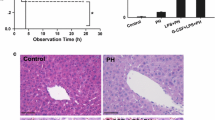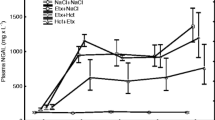Abstract
Purpose
Polymorphonuclear leucocytes (PML) play an essential role in the host immune response to severe infections. The effects of granulocyte-colony stimulating factor (G-CSF) on the PML immune functions during serious abdominal infection and course of sepsis, and on the survival in rats with peritonitis are the main subjects of this study.
Methods
The first phase of the study was carried out on 30 Wistar-albino rats equally divided into three groups; Group 1 (control) sham laparotomy; Group 2 (peritonitis); and Group 3 (peritonitis+G-CSF) with fecal peritonitis created by a cecal puncture. At postoperative hours 3, 12, and 24, 0.5 ml normal saline was injected subcutaneously in groups 1 and 2, and 0.5 ml solution containing 50 µg/kg of G-CSF in group 3. The phagocytic and chemotactic activities of neutrophils and monocytes were evaluated by a flow cytometry analysis. The plasma lactate concentrations were assessed as a marker of tissue perfusion during sepsis. The second phase was a survival analysis, which was observed during 10 days on 20 rats equally divided into two groups; group 1 (peritonitis) and group 2 (peritonitis+G-CSF). 0.5 ml normal saline in group 1 and 50 µg/kg of G-CSF in group 2 was injected subcutaneously at the 3rd hour and twice daily.
Results
Both the neutrophil- (1.636 vs 2.236) and monocyte-related (1.789 vs 2.465) phagocytic activities significantly (P < 0.001) improved after the G-CSF administration in the rats with peritonitis. In addition, the G-CSF treatment significantly (P < 0.0014) improved the chemotactic activity (1.18 vs 2.75) of neutrophils, and partly supported (P < 0.0952) the chemotactic activity (1.69 vs 2.37) of monocytes. The plasma lactate level (1.86 vs 4.9 mmol/l) was significantly (P < 0.0001) increased after septic changes due to experimental peritonitis. On the other hand, the lactate concentration was significantly (P < 0.001) decreased (4.9 vs 2.63 mmol/l) after the G-CSF administration. The survival was 20% at the 4th day and 0 at the 6th day in peritonitis, and 90% at the 4th day (P = 0.0055) and 80% at the 6th day (P = 0.0007) days in the peritonitis+G-CSF groups.
Conclusion
G-CSF enhances the immune functions of neutrophils and monocytes. The increased activities of these cells have a beneficial effect on the enhancement of the host immune response during severe infections. The improved immune function of PML due to the G-CSF treatment thus ameliorates the survival and the courses of sepsis, which is also defined by tissue perfusion and the cellular oxygen balance, which is affected by septic changes.
Similar content being viewed by others
References
DL Dunn GJ Beilman (2005) Surgical infections FC Brunicardi (Eds) Principles of surgery EditionNumber8th ed McGraw-Hill New York 109–27
M Weiss LL Moldawer ME Schneider (1999) ArticleTitleGranulocyte colony-stimulating factor to prevent the progression of systemic nonresponsiveness in systemic inflammatory response syndrome and sepsis Blood 93 425–39 Occurrence Handle9885204 Occurrence Handle1:CAS:528:DyaK1MXjslekug%3D%3D
A Bauhofer B Stinner F Kohlert B Reckzeh W Lorenz I Celik (2002) ArticleTitleGranulocyte colony-stimulating factor but not peritoneal lavage increases survival rate after experimental abdominal contamination and infection Br J Surg 89 1457–64 Occurrence Handle12390392 Occurrence Handle10.1046/j.1365-2168.2002.02227.x Occurrence Handle1:STN:280:DC%2BD38njt1amsg%3D%3D
A Bauhofer A Torossian W Lorenz M Middeke U Plaul P Schutz et al. (2004) ArticleTitleDependence of positive effects of granulocyte colony-stimulating factor on the antibiotic regimen: evaluation in rats with polymicrobial peritonitis World J Surg 28 834–44 Occurrence Handle15457367 Occurrence Handle10.1007/s00268-004-7210-1
GJ Lieschke AW Burgess (1992) ArticleTitleGranulocyte colony-stimulating factor and granulocyte macrophage-colony stimulating factor N Engl J Med 327 28–35 Occurrence Handle1375975 Occurrence Handle1:CAS:528:DyaK38XlsVems7w%3D Occurrence Handle10.1056/NEJM199207023270106
E Gurleyik G Gurleyik S Unalmiser (1996) ArticleTitleBlockade of transdiaphragmatic lymphatic absorption reduced systemic inflammatory response syndrome during experimental peritonitis: Evaluation with body oxygen kinetics in rats Eur J Surg 162 729–34 Occurrence Handle8908455 Occurrence Handle1:STN:280:DyaK2s%2FmsV2jtw%3D%3D
KA Wichterman AE Baue IH Chaudry (1980) ArticleTitleSepsis and septic shock: a review of laboratory models and a proposal J Surg Res 29 189–201 Occurrence Handle6997619 Occurrence Handle10.1016/0022-4804(80)90037-2 Occurrence Handle1:STN:280:DyaL3M%2FhtVyisA%3D%3D
G Rothe A Emmendörfer A Oser J Roesler G Valet (1991) ArticleTitleFlow cytometric measurement of the respiratory burst activity of phagocytes using dihydrorhodamine 123 J Immunol Methods 138 133–5 Occurrence Handle2019742 Occurrence Handle10.1016/0022-1759(91)90074-P Occurrence Handle1:CAS:528:DyaK3MXktVKmt7Y%3D
JR Dunne BJ Dunkin S Nelson JC White (1996) ArticleTitleEffects of granulocyte colony-stimulating factor in a nonneutropenic rodent model of Escherichia coli peritonitis J Surg Res 61 348–54 Occurrence Handle8656607 Occurrence Handle10.1006/jsre.1996.0128 Occurrence Handle1:CAS:528:DyaK28Xitlagu7g%3D
P Zhang JG Bagby DA Stoltz WR Summer S Nelson (1998) ArticleTitleEnhancement of peritoneal leukocyte function by granulocyte colony-stimulating factor in rats with abdominal sepsis Crit Care Med 26 315–21 Occurrence Handle9468171 Occurrence Handle10.1097/00003246-199802000-00035 Occurrence Handle1:STN:280:DyaK1c7islKruw%3D%3D
H Ishikura Y Uedono K Yamagami T Arai N Takeyama T Tanaka (1996) ArticleTitleActivation of neutrophil function by recombinant human granulocyte colony-stimulating factor improves the survival of rats with peritonitis Surg Today 26 694–9 Occurrence Handle8883240 Occurrence Handle10.1007/BF00312086 Occurrence Handle1:CAS:528:DyaK28XmtVSqtrg%3D
JL Vincent R Moreno J Takala S Willatts A De Mendonca H Bruining et al. (1996) ArticleTitleThe SOFA (Sepsis-related Organ Failure Assessment) score to describe organ dysfunction/failure. On behalf of the Working group on Sepsis-Related Problems of the European Society of Intensive Care Medicine Intensive Care Med 22 707–10 Occurrence Handle8844239 Occurrence Handle1:STN:280:DyaK2s%2FgtFantQ%3D%3D
R Lundblad JM Nesland KE Giercsky (1996) ArticleTitleGranulocyte colony-stimulating factor improves survival rate and reduces concentrations of bacteria, endotoxin, tumor necrosis factor, and endothelin-1 in fulminant intraabdominal sepsis in rats Crit Care Med 24 620–6
JP Robinson WO Carter PK Narayanan (1994) Oxidative product formation analysis by flow cytometry Z Darzynkiewies JP Robinson (Eds) Methods in cell biology: flow cytometry Academic Press New-York 437–47
M Weiss W Gross-Weege M Schneider (1995) ArticleTitleEnhancement of neutrophil function by in vivo filgrastim treatment for prophylaxis of sepsis in surgical intensive care patients J Crit Care 10 21–6 Occurrence Handle7538851 Occurrence Handle10.1016/0883-9441(95)90027-6 Occurrence Handle1:STN:280:DyaK2M3ns1yjtg%3D%3D
S Flohe S Lendemans C Selbach C Waydhas M Ackermann U Schade et al. (2003) ArticleTitleEffects of granulocyte colony-stimulating factor on the immune response of circulating monocytes after severe trauma Crit Care Med 31 2462–9 Occurrence Handle14530752 Occurrence Handle10.1097/01.CCM.0000089640.17523.57 Occurrence Handle1:CAS:528:DC%2BD3sXnvVCns7s%3D
A Bauhofer I Celik U Plaul H Wulf A Torossian (2004) ArticleTitleEffects of G-CSF and antibiotic prophylaxis in a 2 × 2 factorial design on outcome in septic rats Inflamm Res 53 IssueIDsuppl 2 126–9
P Villa CL Shaklee C Meazza D Agnello P Ghezzi G Senaldi (1998) ArticleTitleGranulocyte colony-stimulating factor and antibiotics in the prophylaxis of a murine model of polymicrobial peritonitis and sepsis J Infect Dis 178 471–7 Occurrence Handle9697729 Occurrence Handle1:CAS:528:DyaK1cXlsVyqs74%3D
H Toda A Murata N Matsuura K Uda Y Oka N Tanaka et al. (1993) ArticleTitleTherapeutic efficacy of granulocyte-colony stimulating factor against rat cecal ligation and puncture model Stem Cells 11 228–34 Occurrence Handle7686420 Occurrence Handle1:CAS:528:DyaK3sXks1eqsrs%3D Occurrence Handle10.1002/stem.5530110310
Author information
Authors and Affiliations
Rights and permissions
About this article
Cite this article
Gurleyik, G., Yanikkaya, G., Gurleyik, E. et al. Effects of Granulocyte-Colony Stimulating Factor on the Polymorphonuclear Leukocyte Activity and the Course of Sepsis in Rats with Experimental Peritonitis. Surg Today 37, 401–405 (2007). https://doi.org/10.1007/s00595-005-3399-3
Received:
Accepted:
Published:
Issue Date:
DOI: https://doi.org/10.1007/s00595-005-3399-3




